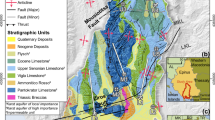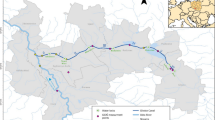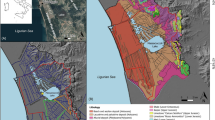Abstract
The salinity distribution in the water and sediment of the Xuanmen estuarine reservoir was investigated by a field survey. Additionally, a sediment flux model was built to predict the solute release from the sediment. The results indicate that the water in the reservoir is currently not suitable for drinking because of its high chloride concentration. The long water retention time is found to be responsible for the high electrical conductivity values in zone II of the reservoir. Our simulations show that the chloride release from the sediment will decrease slowly, nearly stabilizing, in the next 40 years, and the chloride released per stored water volume will be reduced from 5.0 to 2.9 mg/L. The high chloride concentration in the reservoir is probably caused by the extremely uneven distribution of water retention time in the reservoir, whereby the accumulated chloride cannot be effectively diluted by freshwater from the tributaries.







Similar content being viewed by others
References
Bear, J. (1972). Dynamics of fluids in porous media. New York: American Elsevier.
Blasco, J., Sáenz, V., & Gómez-Parra, A. (2000). Heavy metal fluxes at the sediment–water interface of three coastal ecosystems from south-west of the Iberian Peninsula. Science of the Total Environment, 247(2–3), 189–199.
Branco, C. W., Kozlowsky-Suzuki, B., Sousa-Filho, I. F., Guarino, A. W., & Rocha, R. J. (2009). Impact of climate on the vertical water column structure of Lajes Reservoir (Brazil): a tropical reservoir case. Lakes & Reservoirs: Research & Management, 14(3), 175–191.
Cheevaporn, V., Jacinto, G. S., & San Diego-McGlone, M. L. (1995). Heavy metal fluxes in Bang Pakong River Estuary, Thailand: sedimentary vs diffusive fluxes. Marine Pollution Bulletin, 31(4–12), 290–294.
China Soil Society Agricultural Chemistry Committee (CSSACC). (1983). The general analysis methods of soil agricultural chemistry. Beijing: China Science Press (in Chinese).
Chowdhury, M., & Bakri, D. A. (2006). Diffusive nutrient flux at the sediment–water interface in Suma Park Reservoir, Australia. Hydrological Sciences Journal, 51(1), 144–156.
Fan, C., Zhang, L., Qin, B., Wang, S., Hu, W., & Zhang, C. (2004). Estimation on dynamic release of phosphorus from wind-induced suspended particulate matter in Lake Taihu. Science in China Series D: Earth Sciences, 47(8), 710–719.
Gin, K. Y. H., & Gopalakrishnan, A. P. (2009). Sediment oxygen demand and nutrient fluxes for a tropical reservoir in Singapore. Journal of Environmental Engineering, 136(1), 78–85.
Grant, S. B., Litton-Mueller, R. M., & Ahn, J. H. (2011). Measuring and modeling the flux of fecal bacteria across the sediment-water interface in a turbulent stream. Water Resources Research, 47(5), W05517.
Haggard, B. E., Scott, J. T., & Patterson, S. (2012). Sediment phosphorus flux in an Oklahoma reservoir suggests reconsideration of watershed management planning. Lake and Reservoir Management, 28(1), 59–69.
Han, H., Lu, X., Burger, D. F., Joshi, U. M., & Zhang, L. (2014). Nitrogen dynamics at the sediment–water interface in a tropical reservoir. Ecological Engineering, 73, 146–153.
Hannan, H. H., Fuchs, I. R., & Whitenberg, D. C. (1979). Spatial and temporal patterns of temperature, alkalinity, dissolved oxygen and conductivity in an oligo-mesotrophic, deep-storage reservoir in central Texas. Hydrobiologia, 66(3), 209–211.
Huttunen, J. T., Väisänen, T. S., Hellsten, S. K., & Martikainen, P. J. (2006). Methane fluxes at the sediment-water interface in some boreal lakes and reservoirs. Boreal Environment Research, 11(1), 27–34.
Ignatieva, N. V. (1999). Nutrient exchange across the sediment-water interface in the eastern Gulf of Finland. Boreal Environment Research, 4(4), 295–306.
Jin, X., Jiang, X., Yao, Y., Li, L., & Wu, F. C. (2006). Effects of light and oxygen on the uptake and distribution of phosphorus at the sediment–water interface. Science of the Total Environment, 357(1–3), 231–236.
Lee, Y. G., Kang, J. H., Ki, S. J., Cha, S. M., Cho, K. H., Lee, Y. S., Park, Y., Lee, S. W., & Kim, J. H. (2010). Factors dominating stratification cycle and seasonal water quality variation in a Korean estuarine reservoir. Journal of Environmental Monitoring, 12(5), 1072–1081.
Liikanen, A., & Martikainen, P. J. (2003). Effect of ammonium and oxygen on methane and nitrous oxide fluxes across sediment–water interface in a eutrophic lake. Chemosphere, 52(8), 1287–1293.
Lu, Y., & Li, C. (1983). Discussion on the experimental formula of measuring total salt content by conductance method in coastal saline soil of Zhejiang Province. Journal of Zhejiang Agricultural Sciences, 1983(05), 237–242 (In Chinese).
Mu, D., Yuan, D., Feng, H., Xing, F., Teo, F. Y., & Li, S. (2017). Nutrient fluxes across sediment-water interface in Bohai Bay Coastal Zone, China. Marine Pollution Bulletin, 114(2), 705–714.
Pakhomova, S. V., Hall, P. O., Kononets, M. Y., Rozanov, A. G., Tengberg, A., & Vershinin, A. V. (2007). Fluxes of iron and manganese across the sediment–water interface under various redox conditions. Marine Chemistry, 107(3), 319–331.
Park, Y., Cho, K. H., Park, J., Cha, S. M., & Kim, J. H. (2015). Development of early-warning protocol for predicting chlorophyll-a concentration using machine learning models in freshwater and estuarine reservoirs, Korea. Science of the Total Environment, 502, 31–41.
Peng, H., Zheng, X., Chen, L., & Wei, Y. (2016). Analysis of numerical simulations and influencing factors of seasonal manganese pollution in reservoirs. Environmental Science and Pollution Research, 23(14), 14362–14372.
Shackelford, C. D., & Daniel, D. E. (1991). Diffusion in saturated soil. I: Background. Journal of Geotechnical Engineering, 117(3), 467–484.
Shotbolt, L., Hutchinson, S. M., & Thomas, A. D. (2006). Sediment stratigraphy and heavy metal fluxes to reservoirs in the southern Pennine uplands, UK. Journal of Paleolimnology, 35(2), 305–322.
Soares, M. C. S., Marinho, M. M., Huszar, V. L., Branco, C. W., & Azevedo, S. M. (2008). The effects of water retention time and watershed features on the limnology of two tropical reservoirs in Brazil. Lakes & Reservoirs: Research & Management, 13(4), 257–269.
Vukovic, D., Vukovic, Z., & Stankovic, S. (2014). The impact of the Danube Iron Gate Dam on heavy metal storage and sediment flux within the reservoir. Catena, 113, 18–23.
Xia, X., Li, S., & Shen, Z. (2008). Effect of nitrification on nitrogen flux across sediment-water interface. Water Environment Research, 80(11), 2175–2182.
Xu, Z., Woodhouse, J. N., Te, S. H., Gin, K. Y. H., He, Y., Xu, C., & Chen, L. (2018). Seasonal variation in the bacterial community composition of a large estuarine reservoir and response to cyanobacterial proliferation. Chemosphere, 202, 576–585.
Yu, J., Zhang, Y., Zhong, J., Ding, H., Zheng, X., Wang, Z., & Zhang, Y. (2019). Water-level alterations modified nitrogen cycling across sedimentwater interface in the Three Gorges Reservoir. Environmental Science and Pollution Research, 26(32), 1–13.
Funding
This project was supported by the National Natural Science Foundation of China (51878597).
Author information
Authors and Affiliations
Corresponding author
Additional information
Publisher’s Note
Springer Nature remains neutral with regard to jurisdictional claims in published maps and institutional affiliations.
Rights and permissions
About this article
Cite this article
Ruiping, S., Yixuan, H., Yiping, Z. et al. Salinity Distribution and Sediment Flux in the Estuarine Xuanmen Reservoir. Water Air Soil Pollut 231, 315 (2020). https://doi.org/10.1007/s11270-020-04699-4
Received:
Accepted:
Published:
DOI: https://doi.org/10.1007/s11270-020-04699-4




